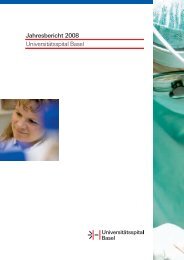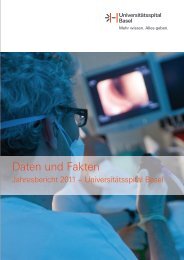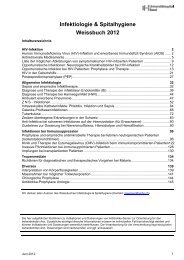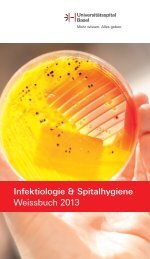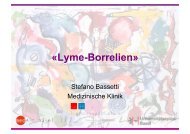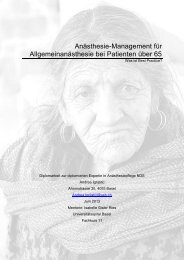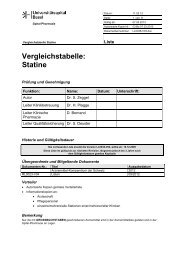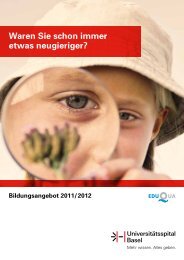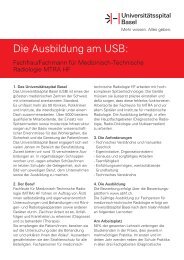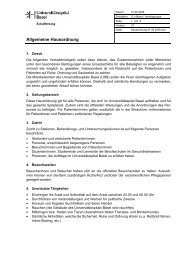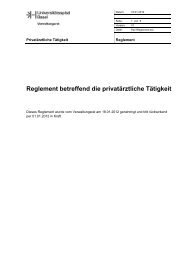Transmucosal Nasal Drug Delivery: Systemic Bioavailability of ...
Transmucosal Nasal Drug Delivery: Systemic Bioavailability of ...
Transmucosal Nasal Drug Delivery: Systemic Bioavailability of ...
Create successful ePaper yourself
Turn your PDF publications into a flip-book with our unique Google optimized e-Paper software.
6. Project II: Pharmacokinetic <strong>of</strong> transmucosal nasal delivered midazolam – impact <strong>of</strong> adjuvants<br />
6.2 Methods<br />
According to the study protocol (see Appendix<br />
10.3.1) non-smoking, healthy volunteers (all<br />
men) age 18 years to 45 years and body mass<br />
index <strong>of</strong> 18 kg/m 2 to 30 kg/m 2 were recruited for<br />
this open-label trial accomplished at the<br />
University Hospital <strong>of</strong> Basel (for study design<br />
see Figure 6-1). Before enrollment, volunteers<br />
were conclusively informed about the study<br />
protocol and all subjects gave written consent.<br />
All interested volunteers then underwent a<br />
medical screening procedure, including<br />
physical examination, medical history, clinical<br />
laboratory testing, and electrocardiogram,<br />
according to the protocol (see Appendix 10.3.2<br />
to 10.3.4). Subjects with acute or chronic nasal<br />
symptoms, clinically significant previous nasal<br />
surgery, nasal trauma or polyps, or any<br />
systemic illness were excluded from<br />
participation. Only volunteers complying with<br />
all inclusions criteria were enclosed. The<br />
volunteers were fasting and abstaining from<br />
beverages containing caffeine from midnight<br />
and until four hours after administration <strong>of</strong><br />
study medication. Sugar free beverages were<br />
allowed. Volunteers received six different<br />
treatments (i.v., Dormicum ® , Roche and nasal<br />
Preparation 1 to 5). All preparations for nasal<br />
administration (Preparation 1 to 5) are<br />
described in Chapter 1. For nasal delivery unit<br />
dose nasal spray (Pfeiffer, GmbH Radolfzell),<br />
delivering 0.1 ml, were used. In Table 6-1 the<br />
applied preparations, midazolam<br />
concentrations, vehicles, the administered<br />
doses, and the application modality are<br />
specified. Two days washout was scheduled<br />
between midazolam administrations.<br />
Screening<br />
1 mg midazolam<br />
3 mg<br />
midazolam<br />
Volunteers<br />
(healthy, male, 18-45 years,<br />
non-smoking, BMI 18-30)<br />
Information<br />
Written consent<br />
Inclusion and exclusion criteria<br />
Enrollment<br />
Dormicum ®<br />
1 mg/ml<br />
1 ml i.v.<br />
Preparation 1<br />
5 mg/ml<br />
2 x 0.1 ml nasal<br />
Preparation 2<br />
5 mg/ml + CD<br />
2 x 0.1 ml nasal<br />
Preparation 3<br />
10 mg/ml + CD<br />
0.1 ml nasal<br />
Preparation 4<br />
30 mg/ml + CD<br />
0.1 ml nasal<br />
Preparation 5<br />
30 mg/ml + CD + CHI<br />
0.1 ml nasal<br />
1 to maximal 2 weeks<br />
Follow-up<br />
2 days<br />
2 days<br />
2 days<br />
2 days<br />
2 days<br />
Figure 6-1: Study design for pharmacokinetic<br />
characterization <strong>of</strong> nasally applied midazolam.<br />
Administration <strong>of</strong> study medication was<br />
separated by two days washout (CD: RMβCD,<br />
CHI: chitosan hydrochloride).<br />
Katja Suter-Zimmermann Page 62 <strong>of</strong> 188 University <strong>of</strong> Basel, 2008




